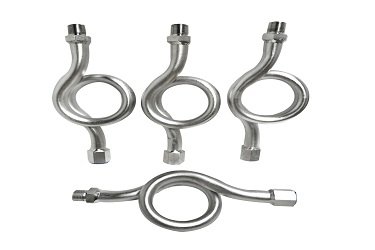A syphon pipe is an essential component in industrial piping systems, designed to transfer fluids using the principle of differential pressure. Unlike conventional pipes that rely solely on pumps or gravity, a syphon pipe utilises atmospheric pressure and fluid column differences to initiate and sustain flow. This mechanism not only reduces energy consumption but also ensures safe and controlled handling of liquids and vapours.
In industries such as power generation, chemical processing, water treatment, and steam applications, syphon pipes play a crucial role in maintaining system efficiency and protecting instrumentation. This article explores the technical aspects of syphon pipes, their construction, working principles, types, and applications across industries.
Principle of Operation
The syphon pipe works on the syphon principle, which is based on fluid mechanics. When a liquid is filled into a bent pipe with one end immersed in a reservoir and the other end placed at a lower elevation, the liquid flows due to:
- Atmospheric Pressure: The weight of the atmosphere on the liquid surface pushes the fluid into the pipe.
- Gravitational Force: Once the fluid passes the highest point of the bend, gravity assists the flow downward.
- Differential Head: The difference in elevation between the inlet and outlet determines the flow rate and capacity.
This self-sustaining flow continues until the fluid level at the source equals or drops below the outlet.
Construction and Materials
Syphon pipes are manufactured in various materials depending on the medium and operating conditions. Common materials include:
- Carbon Steel: Suitable for general industrial use where high strength is required.
- Stainless Steel (SS 304, SS 316): Preferred in corrosive environments such as chemical processing and pharmaceuticals.
- Alloy Steel: Used in high-temperature or high-pressure applications.
- PVC and CPVC: Lightweight and cost-effective for water transfer systems.
Design features:
- Typically bent in a “U” or “pigtail” shape to trap condensate and prevent direct contact of hot fluid (such as steam) with sensitive equipment.
- Available in threaded, welded, or flanged connections for integration with pipelines or gauges.
- Manufactured as per ASME, ASTM, and DIN standards to meet industrial safety norms.
Types of Syphon Pipes
- Pigtail Syphon Pipe (Coil Type)
- A coiled design resembling a pig’s tail.
- Commonly used in steam service to trap condensate and protect pressure gauges.
- U-Type Syphon Pipe
- A U-bend pipe that holds condensate, forming a protective barrier between steam and instrumentation.
- Typically installed in vertical applications.
- Straight Syphon Pipe
- A linear pipe fitted with a small bend to serve as a condensate reservoir.
- Used where installation space is limited.
Applications of Syphon Pipes
1. Steam Systems
In power plants and boiler systems, syphon pipes prevent direct exposure of pressure gauges and transmitters to high-temperature steam. By forming a condensate pocket, they extend the life of sensitive instrumentation.
2. Chemical Processing
Used to transfer corrosive or hazardous liquids between tanks without pumps, relying on the natural syphon effect.
3. Water Treatment Plants
Employed for transferring treated or untreated water between reservoirs, equalising tank levels, or draining systems without mechanical intervention.
4. Oil and Gas Industry
Installed in pipeline networks to control condensate and prevent damage to instrumentation measuring hydrocarbons.
5. HVAC and Refrigeration Systems
Syphon pipes help remove condensate and ensure controlled liquid flow in cooling systems.
Advantages of Syphon Pipes
- Energy Efficiency: Operates without pumps, reducing energy consumption.
- Instrumentation Protection: Creates a condensate barrier that prevents direct exposure of gauges to steam.
- Cost Savings: Low maintenance requirement due to simple design.
- Versatility: Can handle liquids, vapours, and condensates across multiple industries.
- Durability: Manufactured from robust materials to withstand high pressure and temperature.
Technical Standards and Testing
Syphon pipes are produced and tested according to international codes, ensuring reliability in critical applications:
- ASME B31.1 / B31.3 – Piping system standards.
- ASTM A106 / A53 – Carbon steel pipe material standards.
- DIN 16282 – Standards for syphon pipes used with pressure gauges.
Testing includes hydrostatic pressure tests, non-destructive testing (NDT), and dimensional inspection to guarantee performance and safety.
Installation Guidelines
For optimum performance, syphon pipes should be installed with precision:
- Ensure the pipe is pre-filled with water or appropriate condensate before introducing steam.
- Install vertically in the case of U-type syphons to create an effective liquid seal.
- For pigtail syphons, orientation must ensure the coil is positioned correctly to trap condensate.
- Use compatible fittings and gaskets to avoid leakage.
- Conduct periodic inspection to remove scale or blockages.
Industries Benefiting from Syphon Pipes
- Power Generation – Boilers, turbines, and steam distribution lines.
- Petrochemical and Refinery – Monitoring systems exposed to aggressive fluids.
- Pharmaceutical Manufacturing – Hygienic syphons made from SS 316 for sterile processes.
- Food and Beverage Industry – Used in pasteurisation and steam-injected processes.
Conclusion
The syphon pipe is more than a simple bent pipe; it is a vital engineering component ensuring accurate measurement, safe transfer of fluids, and protection of costly equipment. Whether in power plants, chemical factories, or water treatment facilities, syphon pipes provide an energy-efficient and reliable solution for fluid handling.
By combining robust construction, compliance with international standards, and proven performance in challenging environments, syphon pipes remain indispensable in modern industry. For engineers and procurement specialists, understanding the technical details and applications of syphon pipes is crucial to selecting the right product for long-term reliability.
